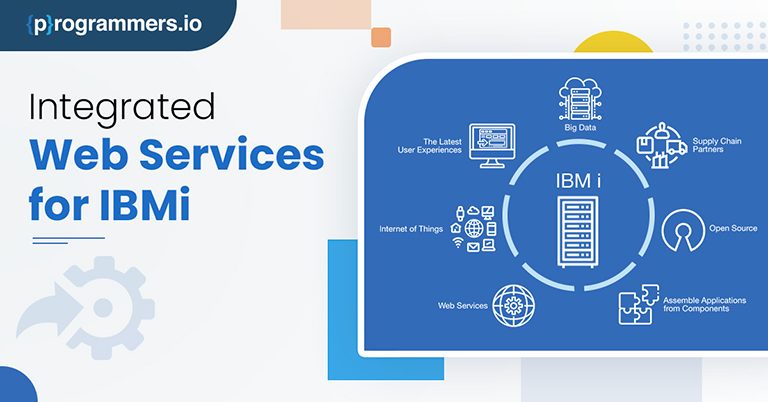Integrated Web Services for IBM i Knowledge Guide
IBM i provides a set of integrated web services, allowing developers to quickly and efficiently create custom web applications. With IBM i web services, organizations can more easily develop and deploy powerful business applications that are tightly integrated with their existing systems.
These applications give users a unified experience across multiple devices and platforms, providing secure access to data and critical business systems. IBM i/AS400 System web services use open standards such as the Representational State Transfer (REST) architecture and Open Data Protocol (OData) to offer a comprehensive solution for creating, managing, and deploying enterprise-grade applications.
These services also provide support for a wide range of development technologies and languages, including PHP, .NET, Java™, Node.js, Angular, and many others. With IBM i integrated web services developers can quickly create intuitive user experiences that are tailored to the needs of their business.
The platform also offers valuable insights through analytics tools, allowing organizations to gain insight into their customer engagement activities and marketing campaigns in real-time.
In addition to its comprehensive set of APIs, IBM i/AS400 provides an array of tools and services to help developers create applications that are optimized for performance and scalability. From application design templates to deployment models, IBM i provides the necessary infrastructure and resources to ensure that applications remain secure, reliable, and compliant with industry standards.
The platform also offers robust support for mobile devices, allowing organizations to quickly deploy their applications across multiple platforms.
By leveraging IBM i integrated web services, organizations can rapidly develop powerful web-based business solutions that are tailored to fit their specific needs. With this comprehensive platform, businesses can easily unlock the power of data-driven insights and improve customer engagement in order to gain a competitive edge in today’s digital world.
How Does a Web Service Work On IBM i Server?
A web service on an IBM i server can be used to provide applications, data, and services to remote users, regardless of their device or location. Web services are a way of exchanging information between two computers over the Internet.
Using web services on an IBM i server involves the set-up of a secure communication channel which is made up of a combination of basic protocols such as Hyper Text Transfer Protocol (HTTP), Simple Object Access Protocol (SOAP), and Web Services Description Language (WSDL).
Once this secure communication channel is established, the user can send requests from their mobile device or computer to access applications, data, and services stored on the IBM i server in real-time. The response from the servers is usually in XML (Extensible Markup Language).
IBM i servers provide a range of web services including IBM WebSphere Application Server, IBM HTTP server, and IBM Portable Application Solution Environment (PASE). These web services can be used to create applications that enable customers to access and use data stored on the IBM i server remotely.
The benefits of using web services on an IBM i server include improved scalability, better resource management, faster response times, and increased efficiency. Additionally, they are easy to implement and maintain as they are based on open standards. This makes them ideal for businesses looking to reduce costs while increasing productivity.
Hence, web services offer an effective way for businesses to expand their reach by providing remote users with access to their applications, data, and services. Furthermore, they can help businesses reduce costs while increasing efficiency, scalability, and resource management.
The IBM i servers provide the necessary infrastructure for web services, which makes them a great choice to deploy web service-based applications on an enterprise level. By using web services on an IBM i server, businesses can take advantage of its capabilities to create secure connections with remote users quickly and easily. This will enable them to provide better services and experiences for their customers.
What Are the Features and Benefits of Integrated Web Services for IBM?
Integrated Web Services for IBM offer a wide range of features and benefits to users. The platform is designed to provide easy access to various web services, allowing users to quickly connect with external systems, applications, and data sources. With this platform, developers can model their applications using the provided building blocks that are optimized for deployment on IBM Cloud.
Some of the key features and benefits of Integrated Web Services for IBM i include:
Flexible Deployment:
IBM offers options for deploying applications in private cloud environments or public cloud platforms such as Amazon Web Services or Microsoft Azure. This provides users with flexibility in choosing which option best meets their needs.
Easy Integration:
The platform makes it easy for developers to integrate their applications with other services, such as databases or messaging systems. This feature reduces the time and effort required to set up and manage connections between different components.
Security Features:
Integrated Web Services for IBM i includes built-in security controls that help protect data from unauthorized access. It also provides identity management capabilities to help ensure users only have access to the resources they need.
Cloud-native Capabilities:
The platform allows developers to take advantage of cloud-native features such as auto-scaling, elasticity, and high availability. This helps optimize performance and reduce costs associated with resource usage.
Robust Tooling:
Integrated Web Services for IBM offers a set of tools designed to simplify application development, deployment, and management. This allows developers to quickly build and deploy applications with minimal effort.
Comprehensive Documentation:
The platform provides comprehensive documentation that is designed to help users get started quickly and easily. The documentation covers topics such as setting up the environment, creating applications, deploying them to the cloud, and managing resources.
These features and benefits make Integrated Web Services for IBM a great choice for businesses looking to take advantage of cloud-native technology without sacrificing security or performance. With this platform, developers can easily create sophisticated applications that are optimized for the cloud and deliver reliable results.
Conclusion
IBM i gives organizations a powerful, reliable platform that is ideal for running integrated web services. By leveraging IBM i technology and the power of IBM’s robust suite of hardware and software solutions, businesses can quickly and easily deploy web services to drive advanced digital transformation initiatives in their organization.
With integrated web services, organizations can create high-performance applications with secure access to cloud-based data and enterprise systems. Organizations have the ability to develop innovative customer experiences, streamline operations and unlock new opportunities for business growth.
As companies continue to move toward more automated systems and greater use of cloud-based technologies, AS400 provides an ideal foundation for delivering integrated web services that help businesses maximize their return on investment.










